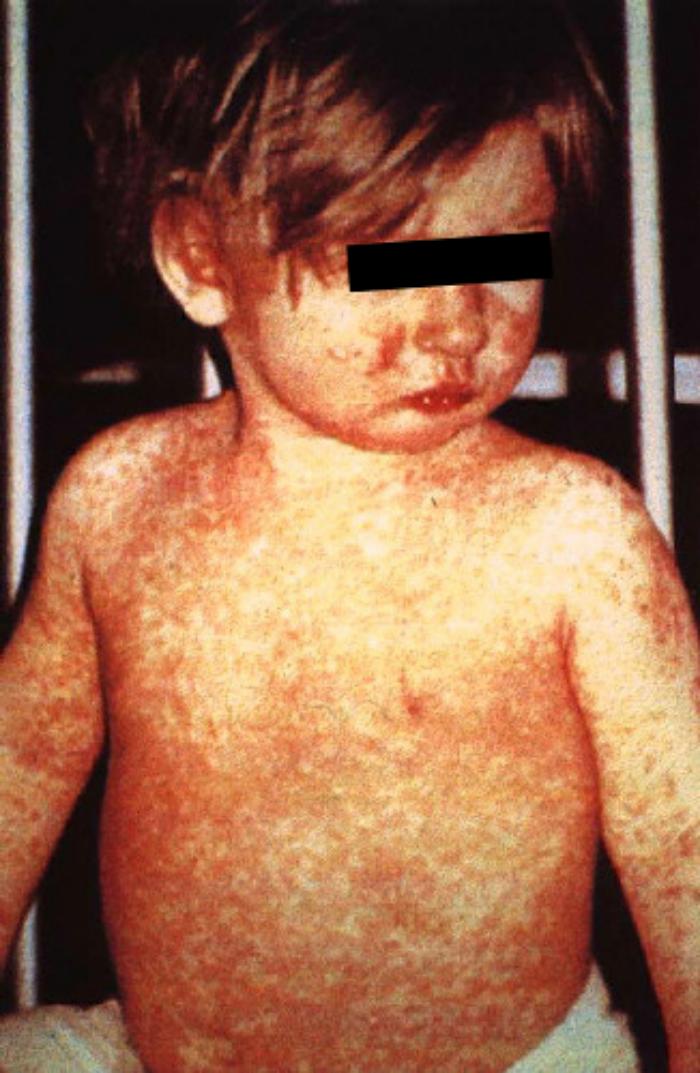
A typical measles rash, courtesy of the public health library, Centers for Disease Control and Prevention
Who knew when we first published this post in June 2014 that another measles outbreak would occur in the US. In light of the numerous measles cases that emerged out of the California Disneyland exposure, we re-publish signs of measles in children. Parents who have children who are not completely immunized against measles should be especially vigilant.
Measles typically starts out looking like almost every other respiratory virus— kids develop cough, runny nose, runny bloodshot eyes, fever, fatigue, and muscle aches.
Around the fourth day of illness, the fever spikes to 104 F or more and a red rash starts at the hairline and face and works its way down the body and out to arms and legs, as shown here at the Immunization Coalition site. Many kids also develop Koplik spots on the inside of the mouth: small, slightly raised, bluish-white spots on a red base 1-2 days before rash. Call your child’s doctor if you suspect that your child has measles. Parents should be most suspicious if their children have not received MMR vaccine or if their immunized child was exposed to a definite case of measles or visited an area with known measles.
In the US, one in 10 kids with measles will develop an ear infection and one in 20 will develop pneumonia. Roughly one in 1000 kids develop permanent brain damage, and up to two in 1000 who get measles die from measles complications. Kids under age 5 years are the most vulnerable to complications. These statistics are found here. For global stats on measles, please see this World Health Organization page.
There is no cure for measles and there no way to predict if your child will have a mild or severe case. Fortunately, one dose of the MMR (Measles, Mumps, Rubella) vaccine is 92-95% effective at preventing measles, and two doses are 97-99% effective at preventing measles. That’s the best we can do, and this protection rate works great when everyone is vaccinated. The American Academy of Pediatrics recommends giving the first dose of MMR vaccine at 12-15 months and the second dose at school entry, between 4-6 years of age.
If parents refuse the MMR vaccination for their children, then more people are left susceptible to measles. This leads to more people who can spread the disease when it hits a community. Measles is one of the most contagious diseases known: 9 out of 10 unvaccinated people exposed to measles will become sick, and infected people are contagious even before symptoms appear. One of the reasons behind the increase in measles cases is the increase in unvaccinated children. One patient of Dr. Kardos’s was a four-year-old boy who was behind on his vaccines and hospitalized for measles pneumonia. Before he was diagnosed he exposed an entire Emergency Department to measles.
In our global world, another reason for the spike in measles cases is the increase in travel between countries. In fact, young children traveling internationally should now get the MMR vaccine outside of the routine schedule. If you plan on traveling, check here to see if you need to give your child the MMR vaccine on an early schedule.
With increased vigilance and vaccination, hopefully measles will once again become a disease few doctors have ever encountered. After all, vaccines did eradicate small pox. The last case of smallpox in the United States was in 1949, and the last case in the world was in 1977. In the meantime, you’ll know how to “spot” a case of measles too.
Julie Kardos, MD and Naline Lai, MD
©2014 Two Peds in a Pod®, updated February 2015



